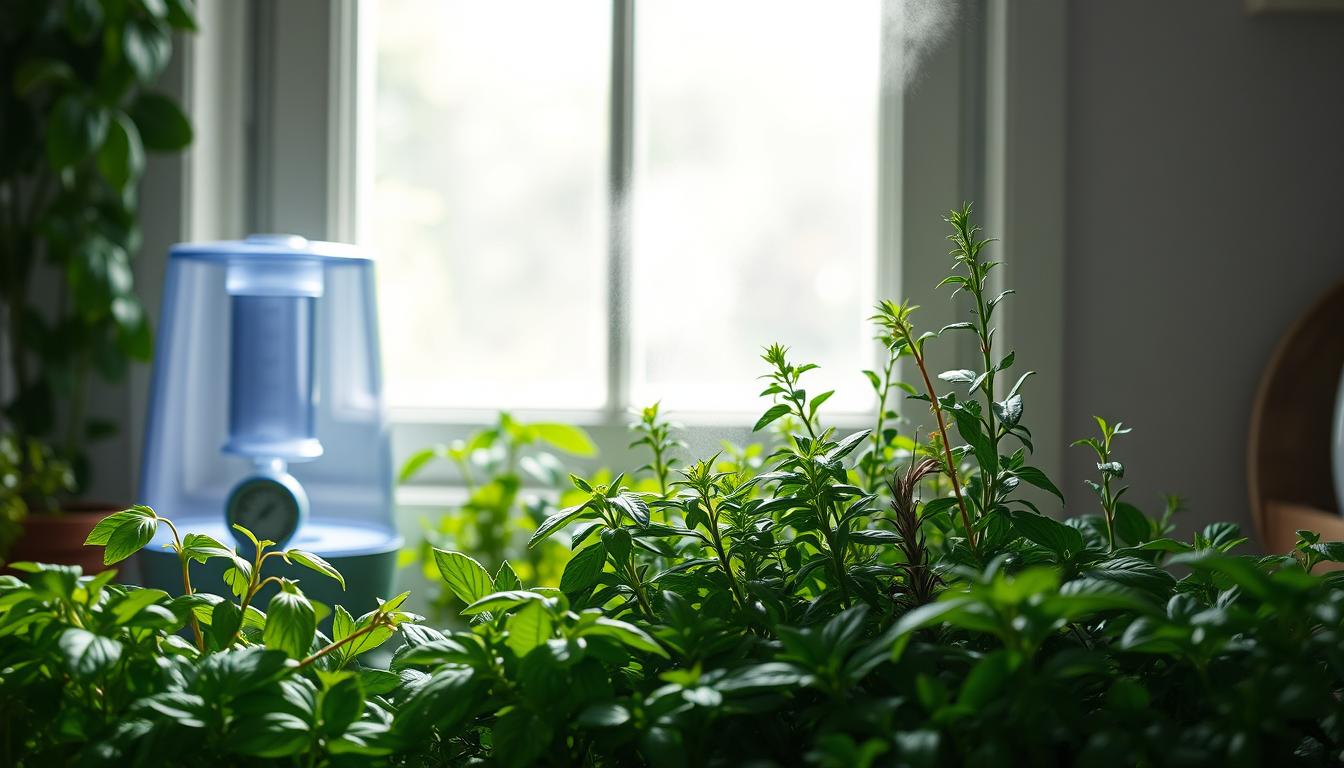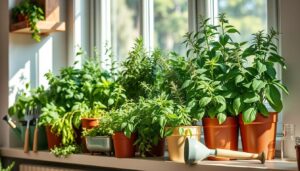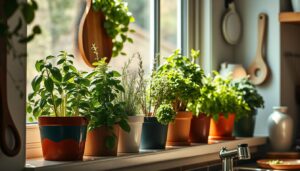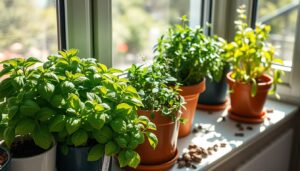Did you know that 80% of indoor herb gardens fail because of bad humidity control? Keeping the right humidity is key for your herbs to grow well. Without it, your herbs might not grow well, get damaged, or even get pests and diseases.
But don’t worry, you can easily manage the humidity in your indoor herb garden. With the right methods, your herbs will flourish.
Key Takeaways
- Proper humidity control is essential for the success of indoor herb gardens.
- Monitoring and maintaining the ideal humidity levels can prevent common issues like stunted growth and disease.
- Utilizing humidifiers, moisture trays, and proper watering techniques can help regulate humidity for your indoor herbs.
- Understanding the specific humidity requirements of different herb varieties is crucial for creating the optimal growing environment.
- Implementing a comprehensive humidity control strategy is a game-changer for your indoor herb garden.
Introduction to Indoor Herb Gardening
Growing indoor herb gardening is rewarding and flavorful. But, it has its challenges. Indoor spaces often lack sunlight, consistent temperatures, and the right humidity for herbs. By tackling these issues, you can make a great indoor herb garden that gives you fresh, aromatic herbs all year.
Challenges of Growing Herbs Indoors
One big challenge is getting enough light. Herbs need at least 6 hours of sunlight a day. But, indoor spaces often don’t have enough light. This can make plants grow poorly, become too tall, and taste less flavorful. Using windows, grow lights, or both is key for a successful indoor herb gardening.
Another issue is watering the soil right. Herbs like soil that drains well, but indoor spaces can dry it out or make it too wet. Finding the right watering balance is tricky. You need to watch your plants closely and adjust as needed.
Benefits of Controlling Humidity for Herb Growth
Humidity control is crucial for your indoor herb gardening. Most herbs do well in moderate humidity levels, between 50-70%. Indoor spaces can get very dry, especially when it’s cold and heaters are on. Keeping the right humidity helps your indoor herbs stay healthy and grow well. It prevents leaves from wilting, stops growth from slowing down, and keeps pests and diseases away.
“Controlling humidity is essential to prevent issues like leaf wilting, stunted growth, and increased susceptibility to pests and diseases.”
Knowing the indoor herb growing challenges and the benefits of controlling humidity for herb growth helps you create a great indoor herb gardening setup. This way, you’ll have fresh, tasty herbs all year.
Choosing the Right Herbs for Indoor Cultivation
Not all herbs are the same when it comes to growing herbs indoors. Some herbs for indoor growing do better than others. Annual herbs like basil, cilantro, and parsley might find it tough with less light and changing temperatures indoors. They don’t match up as well as perennial herbs.
Perennial herbs like mint, oregano, thyme, and rosemary are better for indoor gardens. They adjust well to the indoor challenges of indoor herb gardening. When picking the best herbs to grow indoors, think about what each herb needs for light, temperature, and humidity.
Annual vs. Perennial Herbs
Annual herbs for indoor might look appealing, but they often face challenges with indoor light and temperature changes. In contrast, perennial herbs for indoor growing are more robust. They can handle the indoor environment better.
Herbs Suitable for Indoor Growing
- Mint
- Oregano
- Thyme
- Rosemary
- Chives
- Sage
- Parsley
Choosing the right herbs for indoor growing boosts your chances of success. This way, you can have a flourishing indoor herb garden.
“The key to a successful indoor herb garden is selecting the right herbs that can thrive in the unique challenges of an indoor environment.
Proper Containers and Potting Soil
Choosing the right indoor herb garden containers and herb garden potting soil is key for your indoor herb garden’s success. Herbs do well in soil that drains well and is full of nutrients, made just for containers. Don’t use regular garden soil, as it can pack down and block drainage in pots.
Container Size and Drainage Requirements
Your indoor herb container should fit the herb’s roots, giving them room to grow. As herbs get bigger, they might need bigger pots. Make sure your pots have good drainage holes to stop water from pooling and causing root rot.
Quality Potting Soil for Indoor Herbs
For herb garden drainage and soil quality, the right herb garden potting soil is crucial. Pick a potting mix made for containers, as it has the right aeration, moisture, and nutrients for your herbs to grow well.
- Avoid using dense garden soil, which can become compacted and restrict root growth.
- Choose a lightweight, well-draining potting mix formulated for container gardening.
- Consider adding perlite or vermiculite to improve soil drainage and aeration.
By giving your indoor herbs the right soil and containers, you can create the perfect environment for them to thrive.
Lighting Requirements for Indoor Herb Gardens
For a thriving indoor herb garden, pay close attention to your plants’ lighting needs. Most herbs need at least 6-8 hours of direct sunlight daily. This can be tough indoors, especially in winter when days are shorter.
To meet your plants’ light needs, place containers near south or west-facing windows. This can give them the natural light they need. If natural light isn’t enough, grow lights can be a good option.
Grow lights have improved a lot in energy efficiency and ease of use. They’re a great choice for indoor gardeners. With the right indoor herb lighting requirements, your herbs will grow strong and healthy.
When picking grow lights for your herb garden lighting, choose ones that emit light in the 6,500K to 8,000K range. This spectrum is close to natural daylight and supports healthy growth in your herbs.
- Position grow lights 12-24 inches above your herb plants for the best supplemental lighting for indoor herbs.
- Use a timer to make sure your herbs get 6-8 hours of light daily.
- Keep an eye on your herbs and adjust the lighting as needed for healthy growth.
“Proper lighting is key for a successful indoor herb garden. With the right indoor herb lighting requirements, you can create a thriving oasis at home.”
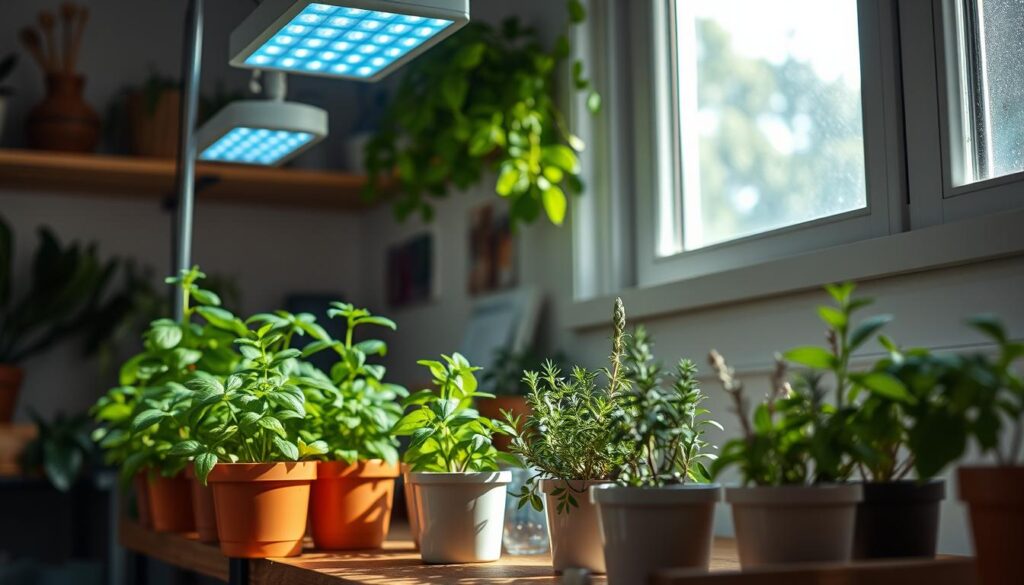
Watering Techniques for Indoor Herbs
Proper indoor herb watering is key for your indoor herb garden’s health and growth. Herbs like evenly moist soil but can get root rot if overwatered. Check the top inch of soil to see if it’s dry before watering. Signs of overwatering include wilting, yellowing leaves, and root rot. Underwatering can make leaves wilt and become brittle.
Having a regular watering schedule, like once or twice a week, helps your herbs get the right moisture. You can use moisture meters to check the soil’s moisture and adjust your watering methods as needed. Learning how to indoor herb watering can keep your herbs healthy and avoid common problems.
Signs of Over or Under-Watering
- Overwatering: Wilting, yellowing leaves, root rot
- Underwatering: Wilting, brittle leaves
Watering Schedules and Methods
- Set a regular watering schedule, like once or twice a week.
- Use a moisture meter to check the soil’s moisture and adjust your watering methods as needed.
- Water the soil directly, not the leaves, to prevent fungal issues.
- Try bottom watering by placing the pot in a tray of water for the soil to absorb moisture from the bottom up.
| Watering Technique | Benefits | Drawbacks |
|---|---|---|
| Top Watering | Easy to do, lets you check soil moisture visually | Can cause uneven moisture, risk of overwatering |
| Bottom Watering | Ensures even moisture, lowers overwatering risk | Takes more time and effort, harder to monitor |
“The key to successful indoor herb gardening is to maintain a consistent watering schedule and monitor soil moisture levels closely.”
Indoor herb garden humidity control
Keeping the right humidity is crucial for your indoor herbs to grow well. Most herbs do best in a humidity of 50-70%. This can be hard to get in many indoor places, especially in the dry winter.
Ideal Humidity Levels for Herb Growth
To get the best humidity for your indoor herbs, aim for 50-70%. This moisture level is perfect for your herbs to grow well. Some herbs like it drier, while others need more moisture.
Humidifiers and Moisture Trays
There are easy ways to keep your indoor herb garden moist. One way is to put your herb pots on trays with pebbles and water. As the water evaporates, it makes the air around your herbs more humid. You can also use a room humidifier to increase the moisture in your space.
Keep an eye on the humidity and adjust it as needed. This will make sure your indoor herbs get the right moisture for growth and health.
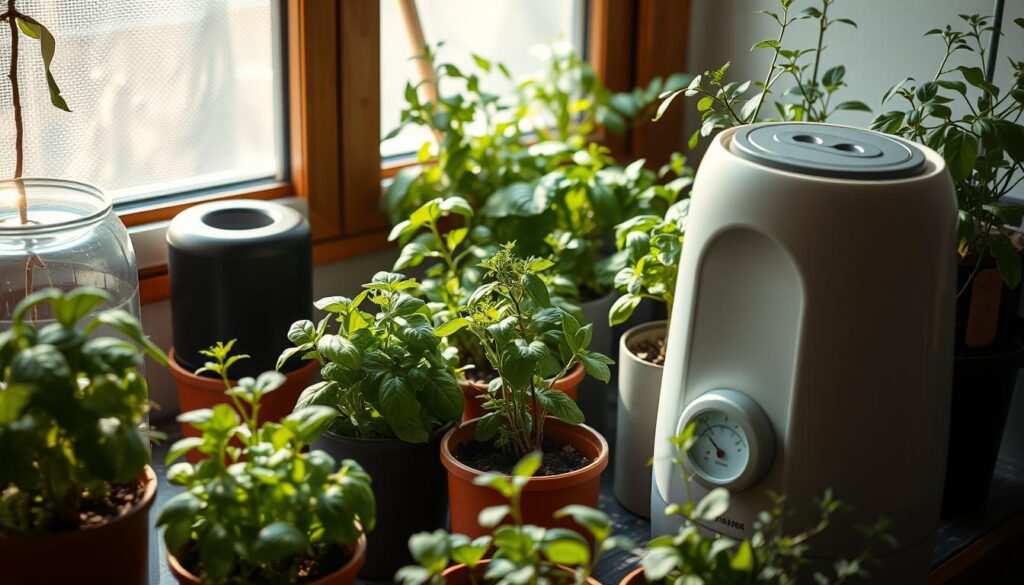
| Humidity Requirement | Herb Examples |
|---|---|
| 50-60% | Rosemary, Thyme, Lavender |
| 60-70% | Basil, Cilantro, Mint |
“Maintaining the proper humidity is key to keeping your indoor herbs healthy and productive.”
Temperature Considerations
Keeping the right temperature is key for your indoor herb garden to grow well. Most herbs do best in a temperature of 60-75°F. This can be hard to keep steady in some indoor places. If your herbs get too hot or too cold, they can get stressed, grow poorly, or even die.
Optimal Temperature Range
The best temperature for indoor herbs is 60-75°F. This temperature is close to what many herbs naturally prefer. Keeping your indoor herb garden in this range helps your herbs grow and develop well.
Avoiding Cold Drafts and Hot Spots
It’s important to keep your herb containers away from cold air, like near windows or air vents. Also, don’t put them near heat sources like radiators or direct sunlight. By placing your herbs carefully, you can keep them away from extreme temperatures.
By watching and adjusting the temperature, you can make a great place for your indoor herbs. With the right temperature and avoiding cold and hot spots, your herbs will likely do well.
Pruning and Harvesting Indoor Herbs
As an indoor herb gardener, it’s key to prune and harvest your plants regularly. Doing so keeps them healthy and productive. Indoor herb pruning helps them grow bushy and prevents them from getting leggy. Indoor herb harvesting is also vital for your plants’ growth and health.
Techniques for Encouraging Bushy Growth
To get your herbs looking lush and full, start pruning them often. Pinching off the tips makes them grow more side shoots, making the plant fuller. Always use clean, sharp scissors or pruners to avoid harming the leaves.
- Pinch off the tips of your herb plants to encourage bushy growth.
- Avoid removing more than one-third of the plant at a time during indoor herb harvesting.
- Use clean, sharp scissors or pruners to make clean cuts and prevent damage.
Harvesting your herbs the right way also helps your garden. Don’t take more than one-third of the plant at once to let it keep growing. With these easy tips, you’ll get more from your herbs and keep your garden looking great.
Pest and Disease Management
Keeping an indoor herb garden healthy means watching out for pests and diseases. Aphids and spider mites can harm your herbs, making them grow poorly, change color, and even die. But, you can fight these pests with organic methods and keep your herbs looking great.
Common Pests for Indoor Herbs
Some pests you might find in indoor herb gardens are:
- Aphids: These small, sap-sucking insects can rapidly multiply, causing leaves to curl and discolor.
- Spider mites: Tiny arachnids that spin fine webs and feed on the undersides of leaves, leading to a speckled, wilted appearance.
- Mealybugs: Soft-bodied insects that hide in crevices and leave a waxy, cotton-like residue on plants.
- Whiteflies: Tiny, white flying insects that congregate on the undersides of leaves and excrete a sticky substance known as honeydew.
- Fungus gnats: Small flies that are attracted to moist soil and can feed on plant roots, leading to stunted growth.
Organic Pest Control Methods
To fight indoor herb pests and indoor herb diseases safely, try these organic pest control methods:
- Neem oil: A natural, plant-derived insecticide that can effectively smother and repel a variety of pests.
- Insecticidal soaps: Made from fatty acids, these gentle yet powerful sprays can eliminate soft-bodied insects without harming your herbs.
- Beneficial insects: Introducing natural predators, such as ladybugs or lacewings, can help reduce pest populations.
- Proper watering and air circulation: Maintaining optimal growing conditions can help prevent disease and make your herbs less susceptible to pests.
By being careful and using these organic pest control tips, you can keep your indoor herb garden safe from pests and diseases. This way, you can enjoy a full harvest without the problems pests and diseases bring.
Rotating and Repotting Indoor Herbs
As your indoor herb garden grows, it’s key to keep up with indoor herb rotation and indoor herb repotting. This ensures your herbs grow evenly and don’t lean towards the light. Also, moving them into bigger pots when needed stops overcrowding and lets roots grow.
For herb container size management, pick containers with good drainage. Use potting soil made for containers. This helps your indoor herbs grow well.
- Rotate your herb containers often to help them grow evenly and stop leaning.
- Move your herbs into bigger pots when they outgrow their current ones, giving roots room to spread.
- Choose containers and soil that drain well and are made for container gardens to meet your herbs’ needs.
| Herb | Recommended Pot Size | Repotting Frequency |
|---|---|---|
| Basil | 6-8 inches | Every 6-12 months |
| Thyme | 4-6 inches | Every 12-18 months |
| Rosemary | 8-10 inches | Every 12-18 months |
By keeping up with indoor herb rotation and indoor herb repotting, you give your plants the space and resources they need. This ensures a thriving indoor herb garden for many years.
Conclusion
Mastering humidity control is key for a thriving indoor herb garden. By knowing what your herbs need and using the right techniques, you can make the perfect environment for them. This guide has shown you how to pick the right herbs and use humidifiers and moisture trays.
Whether you’re experienced or new to gardening, keeping humidity right is crucial. By watching the moisture levels and adjusting when needed, your herbs will get the right humidity for growth. With dedication and the right methods, you’ll enjoy fresh herbs all year.
The summary of indoor herb gardening humidity control is about finding the right balance. By getting this right, you’ll have a lush, full indoor herb garden. It will make your cooking better and please your senses.
FAQ
What are the ideal humidity levels for growing herbs indoors?
What are some effective techniques for controlling humidity in an indoor herb garden?
Which herbs are best suited for indoor cultivation?
What type of containers and potting soil should I use for my indoor herb garden?
How much light do indoor herbs need, and how can I provide it?
How often should I water my indoor herbs, and what are the signs of over or under-watering?
How can I maintain the proper temperature range for my indoor herb garden?
What are some best practices for pruning and harvesting indoor herbs?
How can I prevent and manage pests and diseases in my indoor herb garden?
When should I rotate and repot my indoor herbs?
Source Links
- Grow Your Winter Herb Garden – Twin Cities Agenda – https://tcagenda.com/2017/grow-winter-herb-garden/
- Growing Herbs Indoors & Herb Butter – https://mylifeabundant.com/growing-herbs-indoors/
- Herb Problems Indoors – https://www.missouribotanicalgarden.org/gardens-gardening/your-garden/help-for-the-home-gardener/advice-tips-resources/visual-guides/herb-problems-indoors.aspx


